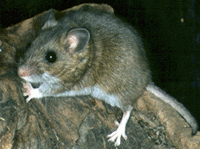House Mice Characteristics
House mice are similar in appearance to the deer mouse, but there are some distinct differences between the mice’s two species.
- Size – Small, slender body with short hair. Wild house mice are commonly 2.5 to 4.3 inches long.
- Color – Light brown to black with cream-colored undersides. The light-colored undersides are less pronounced than those of deer mice.
- Tail – Semi naked and as long as the head and body combined.
- Head – Small head with thin whiskers. The mice have a pointed nose, small eyes, and prominent ears with little hair.
- Habits – Nocturnal pests that can run quickly and stand on their hind legs. These agile mice can jump almost 12 inches to get to food sources and are excellent climbers. These rodents are curious creatures exploring and roaming their territory for food supplies.
- Habitats – Wild mice can be found in fields, grassy and wooded areas in close proximity to humans and food sources. Once the cold winter months hit, they will move indoors into houses, barns, and other buildings for warmth, protection, and food.
- Diet – Mainly feeding on cereal grains, including oats and corn though they will eat almost anything they can find, including meat, soap, and glue.
- Lifecycle – The average lifespan ranges from 9 months to a year. The female house mouse will produce multiple litters and up to 50 offspring within that year, leading to massive population growth if you don’t rid of mice immediately.
Signs Of Deer Mice
House mice infestations can cause serious issues both structural and to human health. If you see any of the following signs of house mouse activity, please call a pest control service specializing in rodent extermination immediately.
- Mouse Droppings – Rod-shaped droppings that are about 1/8 – 1/4 inches long and pointed on both ends. Typically seen in the same location along their pathways and routes to food or clustered near their nests.
- Urine Smell – The house mouse uses urine to communicate with other rodents, attracting females to warning off males. An extensive infestation creates a more pungent musty odor.
- Gnawing – Rough or smooth chew marks are a telltale sign of mice. They chew through wires, plastic, wood, food boxes – just about anything.
- Oily Marks – Mice are oily rodents. You can find grease marks on walls, floors, and baseboards along their regular routes.
- Noises – Scratching and gnawing noises at night in your walls, floorboards, or ceiling can often be heard as they search for foods.
- Burrow & Tunnel Openings – Dimed-sized gnawed holes lead to mouse nests made of soft materials, including insulation, clothing material, or paper.
Call professional mice exterminators if you see any evidence of mouse infestations. House mouse control specialists will help determine the best course of action for effective mouse control and removal.
House Mice Dangers
So there are signs of mice in my home, but so what? There are many reasons why homeowners get rid of mice immediately from their houses.
- Electrical Fires – Mice will chew through just about anything, including your wiring. Not only can this disrupt the modern home – electricity, internet, etc. – but exposed wires lead to an increased fire risk. Live wires with electricity running through them have a higher risk of leading to house fires.
- Structural Damage – Not only do they chew wires, but they also chew through wood, bricks, sheetrock, and other housing materials. The chewing can cause damage to structures and houses while also create entry points for other pests.
- Food Contamination – Mice LOVE food. With a fantastic sense of smell, they can quickly and easily locate sources of food. Gnawing through food boxes and bags, foods become contaminated and inedible.
- Diseases – Mice are carriers of dangerous germs and diseases. Their urine, droppings, and saliva contain germs that cause diseases and viruses, including salmonella and leptospirosis. They also carry ticks, lice, and fleas that can lead to other health issues. While a rare, rat-bite fever can be contracted through contact with a dead mouse.
Call Willard’s Pest Control to discuss the dangers and treatments for mouse removal. Using various bait and trap techniques, we will work with you to take control of the situation.
About Willard’s Pest Control Company
Willard’s Rodent Control Company was established in 1987 as a one-person family exterminator operation. Today, 32 years later, we are a growing family-run exterminator company employing 30+ people. Our extermination business specializes in pest control and treatment for bed bugs, ants, cockroaches, and more.
We believe in providing safe, honest work to the Seattle community and are actively involved in the Washington State Pest Management Association. Through this association, we work to promote professionalism and safety within the pest control industry with effective and efficient mouse extermination methods.
Our service area includes Auburn, Federal Way, Kent, Renton, Tacoma, Woodinville, Seattle, Bellevue, Sammamish, Kirkland, Redmond & Issaquah areas.
